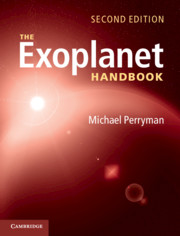Book contents
- Frontmatter
- Contents
- Preface to the Second Edition
- 1 Introduction
- 2 Radial velocities
- 3 Astrometry
- 4 Timing
- 5 Microlensing
- 6 Transits
- 7 Imaging
- 8 Host stars
- 9 Brown dwarfs and free-floating planets
- 10 Formation and evolution
- 11 Interiors and atmospheres
- 12 The solar system
- Appendix A Numerical quantities
- Appendix B Notation and acronyms
- Appendix C Radial velocity exoplanets
- Appendix D Transiting exoplanets
- Appendix E Lensing exoplanets
- Appendix F Imaging exoplanets
- References
- Subject index
- Object index
- Frontmatter
- Contents
- Preface to the Second Edition
- 1 Introduction
- 2 Radial velocities
- 3 Astrometry
- 4 Timing
- 5 Microlensing
- 6 Transits
- 7 Imaging
- 8 Host stars
- 9 Brown dwarfs and free-floating planets
- 10 Formation and evolution
- 11 Interiors and atmospheres
- 12 The solar system
- Appendix A Numerical quantities
- Appendix B Notation and acronyms
- Appendix C Radial velocity exoplanets
- Appendix D Transiting exoplanets
- Appendix E Lensing exoplanets
- Appendix F Imaging exoplanets
- References
- Subject index
- Object index
Summary
The challenge
THERE ARE HUNDREDS OF BILLIONS of galaxies in the observable Universe, with each galaxy such as our own containing some hundred billion stars. Surrounded by this seemingly limitless ocean of stars, mankind has long speculated about the existence of planetary systems other than our own, and the possibility of life existing elsewhere in the Universe.
Only recently has evidence become available to begin to distinguish the extremes of thinking that has pervaded for more than 2000 years, with opinions ranging from ‘There are infinite worlds both like and unlike this world of ours’ (Epicurus, 341–270 BCE) to ‘There cannot be more worlds than one’ (Aristotle, 384–322 BCE).
Shining by reflected starlight, exoplanets comparable to solar system planets will be billions of times fainter than their host stars and, depending on their distance, at angular separations from their accompanying star of, at most, a few seconds of arc. This combination makes direct detection extraordinarily demanding, particularly at optical wavelengthswhere the star/planet intensity ratio is large, and especially from the ground given the perturbing effect of the Earth's atmosphere.
Alternative detection methods, based on dynamical perturbation of the star by the orbiting planet, delivered the first tangible results around 1990. Radio pulsar timing achieved the first convincing detection of planetary mass bodies beyond the solar system (Wolszczan & Frail, 1992). High-accuracy radial velocity (Doppler) measurements yielded the first suggestions of planetary-mass objects surrounding main sequence stars from the late 1980s (Campbell et al., 1988; Latham et al., 1989; Hatzes & Cochran, 1993), with the first essentially unambiguous detection in 1995 (Mayor & Queloz, 1995).
Progress since 1995 This discovery precipitated a changing mindset. The search for exoplanets, and their characterisation, rapidly became a respectable domain for scientific research, and one equally quickly supported by funding authorities. More planets were discovered by radial velocity search teams in the following years. In 1998, the technique of gravitational microlensing provided evidence for a low-mass planet orbiting a star near the centre of the Galaxy nearly 30 000 light-years away, with the first confirmed microlensing planet reported in 2004. In the photometric search for transiting exoplanets, the first transit of a previouslydetected exoplanetwas reported in 1999, the first discovery by transit photometry in 2003, the first of the widefield bright star survey discoveries in 2004, and the first discovery from space observations in 2008.
- Type
- Chapter
- Information
- The Exoplanet Handbook , pp. 1 - 16Publisher: Cambridge University PressPrint publication year: 2018



